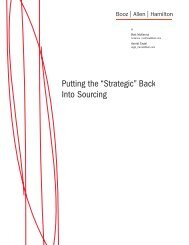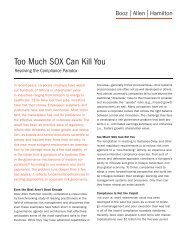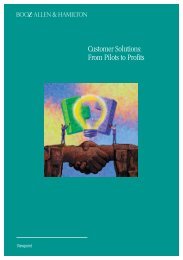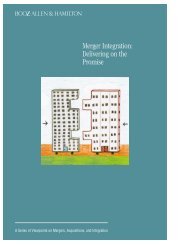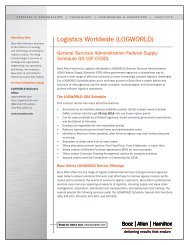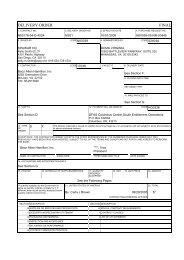Building the Enterprise - Booz Allen Hamilton
Building the Enterprise - Booz Allen Hamilton
Building the Enterprise - Booz Allen Hamilton
- No tags were found...
You also want an ePaper? Increase the reach of your titles
YUMPU automatically turns print PDFs into web optimized ePapers that Google loves.
ing principles, we would constructa set of common policies and practicesthat are so fundamental that<strong>the</strong>y, too, should cover every federalagency, regardless of mission or circumstance—forexample, a commonbut modernized job classificationsystem to ensure generally equal payfor equal work across agencies anda common, market-based compensationregime tied to that classificationstructure to ensure parity with<strong>the</strong> U.S. labor market. A commonsenior executive corps—today <strong>the</strong>reas many as seven—would foster interagencymobility and <strong>the</strong> developmentand deployment of <strong>the</strong> cadreof leaders so critical to enterprisegovernment.The enterprise civil service systemwe propose is not rigid. There istoo much variety—in statutory base,size and scope, mission, constituencyand budget—across <strong>the</strong> federalenterprise to force lockstep uniformity.Instead, it would balance commonalityat <strong>the</strong> core with built-inagency flexibility. Thus, agencieswould be given considerable discretion—moreso than today’s rules allow—totailor elements of <strong>the</strong> commonstructure to meet <strong>the</strong>ir ownunique needs so long as <strong>the</strong>y staytrue to <strong>the</strong> system’s foundational elementsand parameters.For example, we would permitagencies to customize salary ratesfor mission-critical occupations,promotion and career patterns, performancemanagement policies anda host of o<strong>the</strong>r workplace practices.Consistent with today’s demonstrationauthority, we would affordagencies <strong>the</strong> authority to customizeeven components that are intendedto be common across <strong>the</strong> enterprise,subject to collective bargainingwhere required. An agency wouldearn approval to operate a customizedsystem by demonstrating highmission performance, includingemployee engagement and high internalintegrity, as well as by showingthat it has <strong>the</strong> human capital andleadership capacity necessary to operateresponsibly outside <strong>the</strong> lines.This autonomy would have to be periodicallyreexamined and renewed.Such a civil service systemwould improve <strong>the</strong> ability of <strong>the</strong>enterprise to recruit and retain ournation’s best and brightest talent.None<strong>the</strong>less, much would dependon <strong>the</strong> substance of <strong>the</strong> human capitalpolicies. And if <strong>the</strong>re is one lessonwe have learned over <strong>the</strong> decades“The civil service today reflects<strong>the</strong> needs and characteristics of<strong>the</strong> last century’s governmentwork and workforce, not thoserequired for today’s complex,interagency challenges.since <strong>the</strong> last time <strong>the</strong> civil servicesystem was modernized, it is <strong>the</strong> importanceof strategic human capitalplanning.Thus, OPM should devise anenterprise strategic human capitalplan with consultation from enterprisegoal leaders and ratified by <strong>the</strong>PMC. The plan would have two primarypurposes. First, it would lookinto <strong>the</strong> near- and medium-term futureto address critical, cross-cuttinghuman capital challenges affectingmost agencies—for example, recruitingand retaining talent in cybersecurityand science, technology, engineeringand math.The second purpose would be tocontinuously assess <strong>the</strong> enterpriseefficacy of human capital policiesand strategies. This rarely is donetoday.OPM evaluates individual departmentsand agencies, mostly froma compliance standpoint. But it hasnot stepped back to evaluate froma whole-of-government perspectiveregarding how well <strong>the</strong> GeneralSchedule classification systemstacks up against state-of-<strong>the</strong>-artprivate-sector practices, <strong>the</strong> effectsof pay freezes on retention or <strong>the</strong>value of tuition loan repayment onrecruiting talent. Such comparisonslargely have been left to <strong>the</strong> GAO or<strong>the</strong> Merit Systems Protection Board.Both do a credible job, but <strong>the</strong>ir studiesrarely translate into action.This would change under anenterprise strategic human capitalplanning process that regularlyconsiders such issues, assesses <strong>the</strong>irimpact on <strong>the</strong> ability of agencies andenterprise goal leaders to recruitand retain talent, and proposes andputs into effect medium- and longtermsteps to address human capitalneeds. •”22 PARTNERSHIP FOR PUBLIC SERVICE | BOOZ ALLEN HAMILTON





